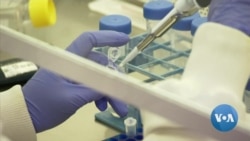An HIV-positive man in Britain has become the second known adult worldwide to be cleared of the AIDS virus. At a conference in Seattle, the U.N. agency leading the global effort to end AIDS said the agency is greatly encouraged by the possibility of an HIV-positive man being cured, but there is still a long way to go.
Scientists have been searching for a cure for HIV/AIDS for close to 40 years. The director of UNAIDS called news that a man in London has been functionally cured of HIV a "breakthrough." Stephane Dujarric, a spokesman for the U.N. secretary-general, made the announcement.
"The breakthrough gives us great hope for the future, but also shows how far we are from the point of ending AIDS with science, as well as the absolute importance to continue to focus on HIV prevention and treatment efforts,” he said.
The London man is HIV-free after receiving a stem cell transplant from a donor with a rare genetic mutation that made him resistant to HIV. His cancer has also gone into remission.
Professor Ravindra Gupta at University College London said the man is now off anti-AIDS medication.
"We waited 16 months before stopping in the post-transplant period just to make sure that the cancer was in remission, the patient was well and that the measures we had of the HIV reservoir in the body showed that there was very, very little virus there, if any at all," he said.
Gupta hesitates to call it a cure, but this is the second patient to show no signs of the HIV virus after a similar stem cell transplant. The first man was an American treated in Berlin 12 years ago. Dr. Rowena Johnston, director of research at amfAR, the Foundation for AIDS Research, says this second success is significant.
"We now have reason to believe that the Berlin patient was not a one-off case... meaning it is possible to nearly, or even completely, eliminate HIV from an infected person," he said.
Just like the Berlin patient, Gupta says the British man who is being called the "London patient," also received stem cells from a donor with a rare mutated gene called CCR5.
"If you transplant those cells into someone who already has HIV, you may protect those new cells from infection," he said.
Some 37 million people across the globe have HIV. But stem cell treatment is not a practical cure. First, a donor has to be tissue matched. Plus, the donor has to have the mutated gene. And then there's the procedure itself, which is painful and risky.
Dr. Sarah Fidler, a professor in HIV medicine at Imperial College London, says a bone marrow transplant would be too dangerous for patients who are healthy and taking a daily pill to treat HIV.
"Having a bone marrow transplantation is a very complicated process," she said. "It requires an entirely new set of cells to be taken into the person who's having treatment and that again is a process where whilst those cells are embedding, you're very at risk of getting infections and potentially dying."
Both patients were being treated for cancer and had no option but to try the risky procedure. Scientists will continue to search for other ways to cure HIV, but now they know it can be cured.











